Item number: 57543
A sterling silver cutlery set in “Acanthus” pattern,
Copenhagen post 1945 by Georg Jensen
A large sterling silver cutlery for twelve persons in “Acanthus” pattern, in Denmark also known as “Dronning”. Designed by Johan Rohde, 1917. Executed by Georg Jensen silversmithy post 1945.
This Acanthus flatware service consists of twelve piece each time (please refer to the first image, from left to right):
Butter knives with sterling silver blade, large sized soup spoons, dinner knives, dinner forks, dinner spoons, fish knives, fish forks, luncheon knives, luncheon forks, luncheon spoons, long drink spoons, cake forks and coffee spoons. 156 pieces in total.
Due to the useful compilation this cutlery is suitable for all variations of starters as well as main course and desserts. An elegant cutlery of lasting value, one of the most iconic designs by Georg Jensen. All pieces have been profesionally polished by our silversmith, the cutlery is in near perfect condition showing only very minor signs of use. Parts of them still were in their original wrapping from the 1950ies and have never been used. The cutlery does not show any personal engraving as monograms or inscriptions. In addition the cutlery comes in custom-made old cutlery box with a new inner compartment. The soup spoons and the long drink spoons on their own are rarities and hard to find. Besides that the long drink spoons allow a wider range of use as these can be utilised not only as long drink spoons but also as ice coffee or ice spoons.
The cutlery is no longer in production and as a full service for twelve persons in fitted cutlery box it is hard to find. The cutlery box dates from circa 1900, it shows two doors to the front and is closed by a hinged cover. The silver cutlery is placed in the three upper drawers, the last drawer at the bottom is empty. The new owner has there the possibility to place serving pieces or accessories as napkin rings. The cutlery box can be removed from the undertable.
Lengths and total weights:
Butter knives (with sterling silver blade): 15.0 cm / 5.90″; 400.1 g
Soup spoons: 16.5 cm / 6.49″ ; 570.9 g
Dinner knives: 22.5 cm / 8.85″
Dinner forks: 18.3 cm / 7.20″ ; 558.3 g
Dinner spoons: 19.0 cm / 7.48″ ; 648 g
Fish knives: 20.9 cm / 8.22″ ; 516.7 g
Fish forks: 17.0 cm / 6.69″ ; 494.1 g
Luncheon knives: 20.5 cm / 8.07″
Luncheon forks: 16.5 cm / 6.49″ ; 457.6 g
Dessert spoons: 17.2 cm / 6.77″ ; 523.3 g
Long drink spoons: 18.2 cm / 7.16″ ; 394.8 g
Cake forks: 14.2 cm / 5.59″ ; 310.6 g
Coffee spoons: 11.4 cm / 4.48″ ; 180.0 g
Total weight: 5054.4 g (without knives with steel blade)
Johan Rohde and Georg Jensen
The Danish painter, graphic artist, architect and interior designer Johan Rohde [1856 – 1935] was a co-founder of the secessionist group “Den Frie Udstilling” (“The Free Exhibition”) in 1891. Through this group he met Georg Jensen, who exhibited a sculpture rejected by the Danish Academy at “Den Frie Udstilling” in 1897. Georg Jensen intended to pursue a career as a sculptor at a young age before he had unexpected success with his silverware. Born in 1866 as the son of a knife grinder in Raadvad, north of Copenhagen, Georg Jensen began training as a silversmith at the age of 14 and became a journeyman in 1884. From 1887 to 1892 he studied sculpture at the “Kongelige Danske Kunstakademi” (“Royal Danish Academy of Art”), followed by studies in pottery. However, economic difficulties forced Georg Jensen to abandon his artistic ambitions in sculpture and pottery and to rededicate himself to silver. Therefore, he worked in Mogens Ballin’s silversmithy from 1901. Nevertheless, the knowledge he acquired at the academy was later of great benefit when he combined it with his specialist knowledge of silversmithing and thus revived the lost tradition of the classical craftsman. His designs for jewellery and silverware, strongly influenced by Scandinavian Art Nouveau, soon found public favour, encouraging Georg Jensen to leave his position with Mogens Ballin and establish his own workshop in Copenhagen in 1906. Georg Jensen and Johan Rohde became friends during their time at Mogens Ballin’s silversmithy, for which Johan Rohde provided designs. Rohde’s first designs for silverware, which he created for his own house in 1905, were executed by Georg Jensen. From 1908, Johan Rohde began a casual collaboration with Georg Jensen. It was not until 1917 that Rohde became a permanent designer of silverware for Georg Jensen, where he remained until his decease.
Among Johan Rohde’s most successful designs for Georg Jensen are the silver cutlery “Acorn” (also known as “Konge”), as well as the cutlery “Scroll” or “Saga” and “Acanthus” (or “Dronning”). Among the larger silverware, the silver carafe #432, which has become a design icon, and the silver services of the “Cosmos” pattern have become particularly famous.

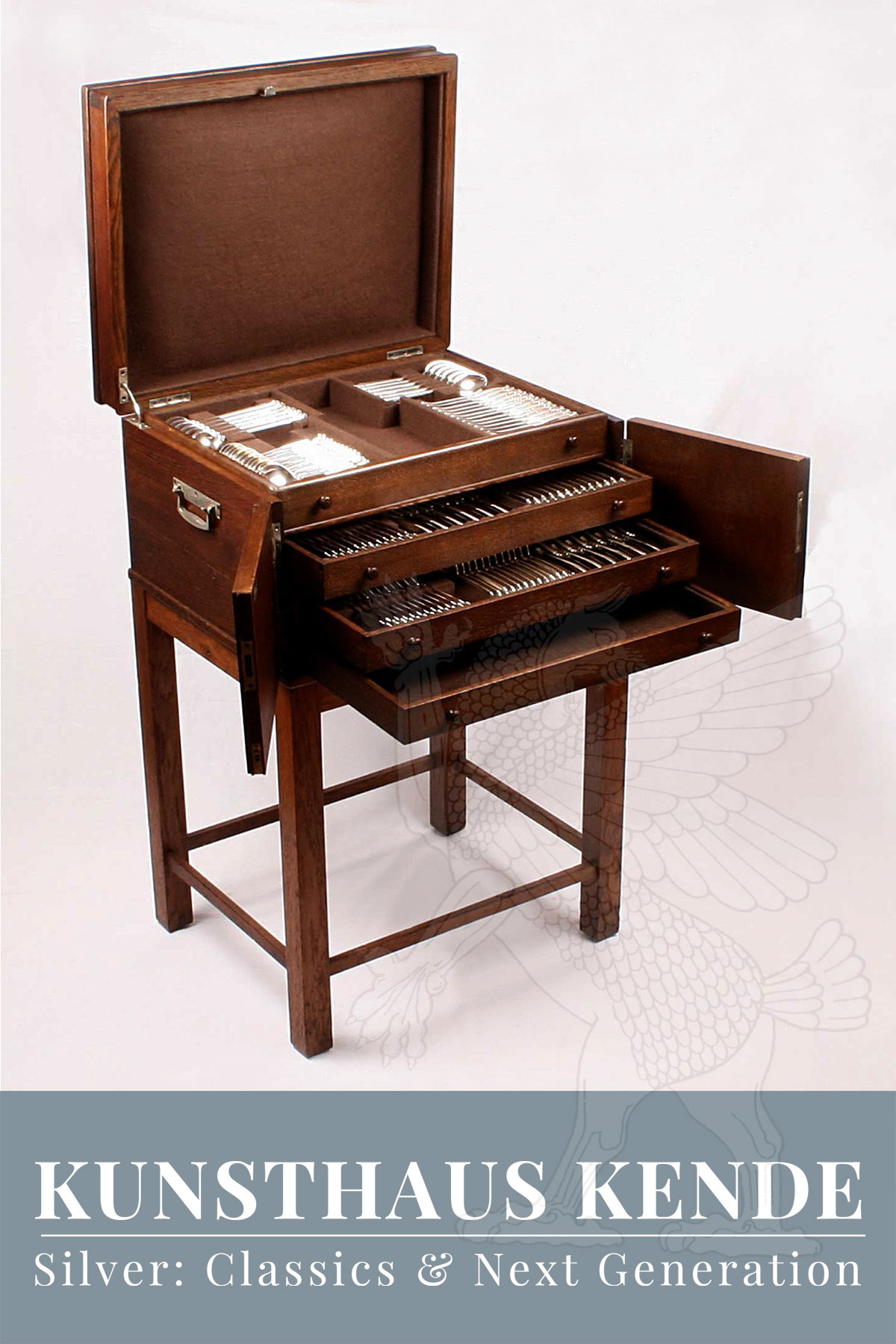
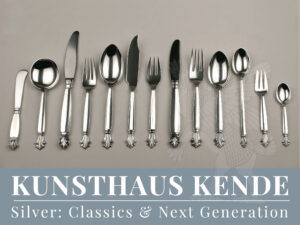
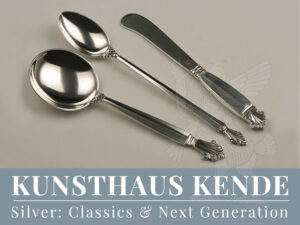
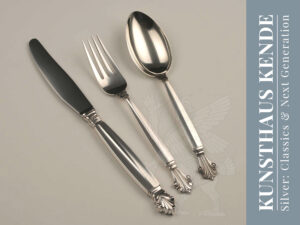
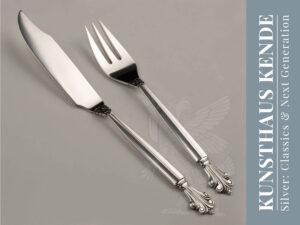
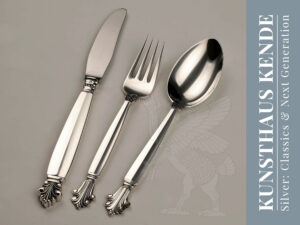
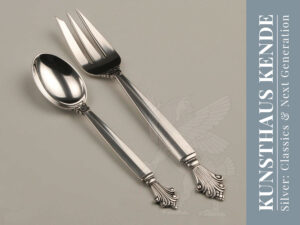
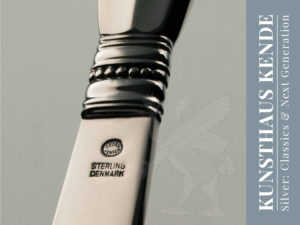
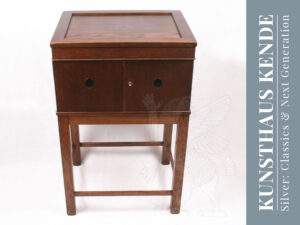
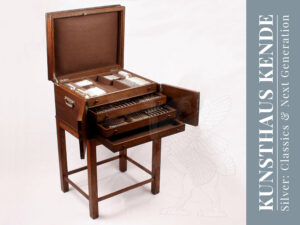
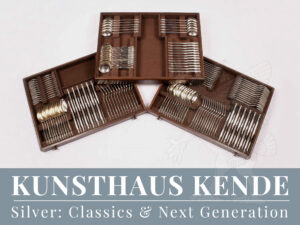
![[:en]Greif Kunsthaus Kende[:]](https://kunsthaus-kende.de/wp-content/uploads/greif_kunsthaus-kende-238x300.png)

